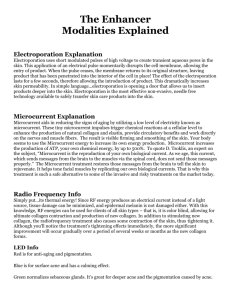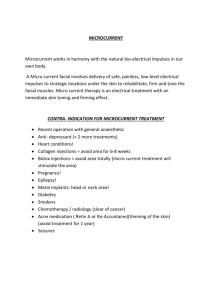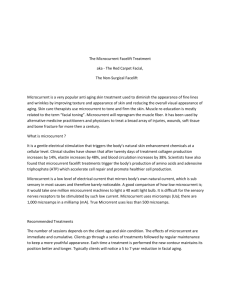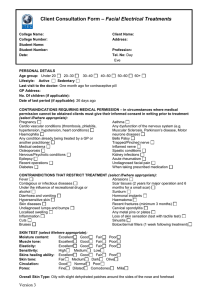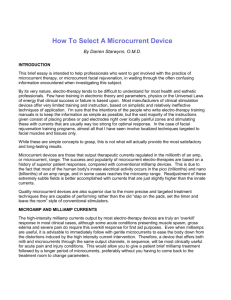The Effect of Microcurrent Electrical Stimulation on the Foot Blood
advertisement
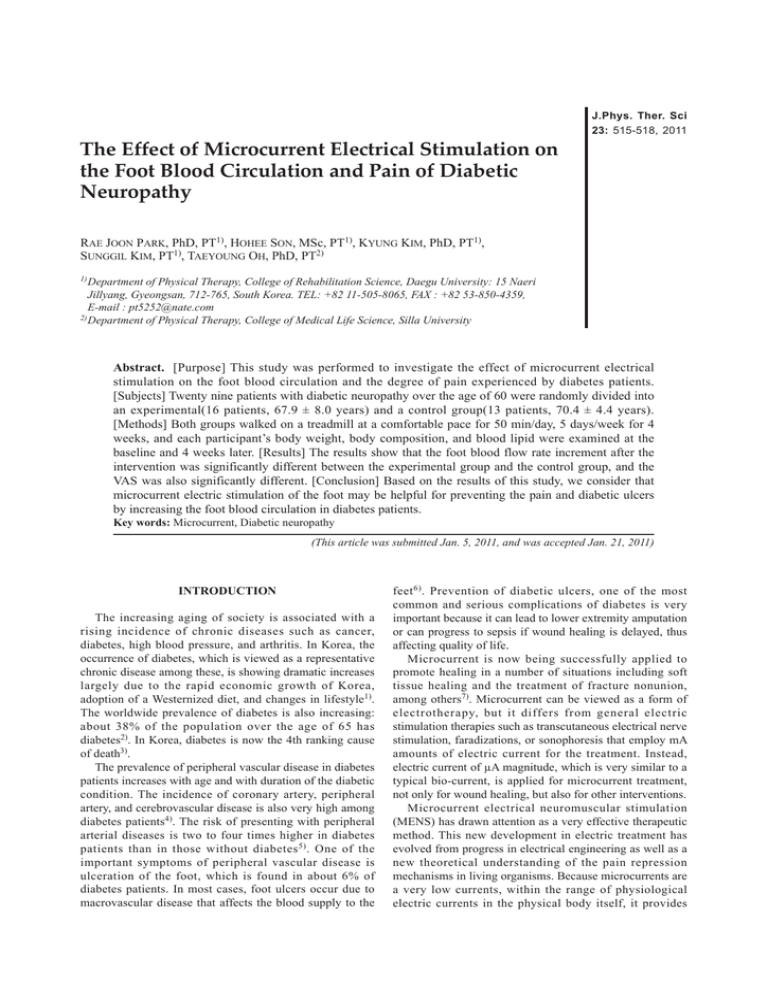
J.Phys. Ther. Sci 23: 515-518, 2011 The Effect of Microcurrent Electrical Stimulation on the Foot Blood Circulation and Pain of Diabetic Neuropathy RAE JOON PARK, PhD, PT1), HOHEE SON, MSc, PT1), KYUNG KIM, PhD, PT1), SUNGGIL KIM, PT1), TAEYOUNG OH, PhD, PT2) 1) Department of Physical Therapy, College of Rehabilitation Science, Daegu University: 15 Naeri Jillyang, Gyeongsan, 712-765, South Korea. TEL: +82 11-505-8065, FAX : +82 53-850-4359, E-mail : pt5252@nate.com 2) Department of Physical Therapy, College of Medical Life Science, Silla University Abstract. [Purpose] This study was performed to investigate the effect of microcurrent electrical stimulation on the foot blood circulation and the degree of pain experienced by diabetes patients. [Subjects] Twenty nine patients with diabetic neuropathy over the age of 60 were randomly divided into an experimental(16 patients, 67.9 ± 8.0 years) and a control group(13 patients, 70.4 ± 4.4 years). [Methods] Both groups walked on a treadmill at a comfortable pace for 50 min/day, 5 days/week for 4 weeks, and each participant’s body weight, body composition, and blood lipid were examined at the baseline and 4 weeks later. [Results] The results show that the foot blood flow rate increment after the intervention was significantly different between the experimental group and the control group, and the VAS was also significantly different. [Conclusion] Based on the results of this study, we consider that microcurrent electric stimulation of the foot may be helpful for preventing the pain and diabetic ulcers by increasing the foot blood circulation in diabetes patients. Key words: Microcurrent, Diabetic neuropathy (This article was submitted Jan. 5, 2011, and was accepted Jan. 21, 2011) INTRODUCTION The increasing aging of society is associated with a rising incidence of chronic diseases such as cancer, diabetes, high blood pressure, and arthritis. In Korea, the occurrence of diabetes, which is viewed as a representative chronic disease among these, is showing dramatic increases largely due to the rapid economic growth of Korea, adoption of a Westernized diet, and changes in lifestyle1). The worldwide prevalence of diabetes is also increasing: about 38% of the population over the age of 65 has diabetes2). In Korea, diabetes is now the 4th ranking cause of death3). The prevalence of peripheral vascular disease in diabetes patients increases with age and with duration of the diabetic condition. The incidence of coronary artery, peripheral artery, and cerebrovascular disease is also very high among diabetes patients4). The risk of presenting with peripheral arterial diseases is two to four times higher in diabetes patients than in those without diabetes 5) . One of the important symptoms of peripheral vascular disease is ulceration of the foot, which is found in about 6% of diabetes patients. In most cases, foot ulcers occur due to macrovascular disease that affects the blood supply to the feet 6) . Prevention of diabetic ulcers, one of the most common and serious complications of diabetes is very important because it can lead to lower extremity amputation or can progress to sepsis if wound healing is delayed, thus affecting quality of life. Microcurrent is now being successfully applied to promote healing in a number of situations including soft tissue healing and the treatment of fracture nonunion, among others7). Microcurrent can be viewed as a form of electrotherapy, but it differs from general electric stimulation therapies such as transcutaneous electrical nerve stimulation, faradizations, or sonophoresis that employ mA amounts of electric current for the treatment. Instead, electric current of μA magnitude, which is very similar to a typical bio-current, is applied for microcurrent treatment, not only for wound healing, but also for other interventions. Microcurrent electrical neuromuscular stimulation (MENS) has drawn attention as a very effective therapeutic method. This new development in electric treatment has evolved from progress in electrical engineering as well as a new theoretical understanding of the pain repression mechanisms in living organisms. Because microcurrents are a very low currents, within the range of physiological electric currents in the physical body itself, it provides 516 J. Phys. Ther. Sci. Vol. 23, No. 3, 2011 advantages such as increased sensory comfort and excellent stability, with no muscular contraction, electrical discomfort, or significant side effects8). Low electric stimulation is a promising approach for angiogenic therapy9,10). Electric field stimulation is known to enhance the secretion of growth factors11). A distinct therapeutic effect of ultra-low microcurrent has also been reported for diabetes, high blood pressure, and wound healing in recent reports12). In Korea, microcurrent has been shown to delay the onset of myalgia13), improve sympathetic nerve tone14), promote wound healing15), increase β-endorphin and pain threshold levels16), repress bacterial growth17), reduce foot muscular fatigue and pain18), and increase the blood flow rate19,20). Pain alleviation and tissue changes induced by microcurrent therapy have been observed during treatment of myofascial pain syndrome patients with chronic back pain 21). Based on these reports, microcurrent is clearly effective in pain alleviation, tissue regeneration, facilitating wound and fracture healing, repressing bacterial growth, and improving the blood flow rate by relieving tension in the sympathetic nervous system. In the present study, our aim was to search for methods that would promote the health of diabetes patients. Our approach was to investigate the effect of microcurrent electrical stimulation, provided through a shoe, on blood circulation and pain in the feet of diabetes patients. SUBJECTS AND METHODS The subjects of this study were selected from among diabetes patients over the age of 60 living in P city. The study included 32 subjects who were without complications of the heart, kidneys, nerves, and retinas, whose fasting blood glucose was over 120 mg/l, who complained of pain or tingling of the feet that was diagnosed as neuropathy and were being treated with medicines, and who did not ingest any food that could affect blood circulation during the experiment. Having understood the purpose of the study and voluntarily agreeing to participate, the subjects were randomly arranged into an experimental and control group to perform a double blind study. The general characteristics of the 29 subjects who completed the exercise program (3 subjects who failed to continue the exercise program during the experiment were excluded) are given in Table 1. The measurement of the blood flow rate in the feet of the diabetes patients was performed at a laboratory temperature maintained at 24 ± 1 ℃ and a humidity of 50 ± 10%. The subjects were allowed to take a rest for one hour before the laboratory test. Blood flow rate in the feet was then measured using the Biopac System MP150 pulse plethysmogram (Biopac System, Inc., USA). The subjects assumed a supine position before the measurement and the stable blood flow rate was measured for 30 seconds in that position and again after one hour of walking exercise. A simple sensor was attached to the tip of the subject’s toe and the stable real-time flow rate variation was monitored in the supine position. To eliminate individual differences and to allow comparison of the experimental Table 1. General characteristics of the subjects Experimental Group Control Group Gender(M/F) 4/12 7/6 Age(yr) 67.88±7.99 70.38±4.35 Height(cm) 159.56±7.16 162.15±5.51 Weight(kg) 59.13±8.52 63.77±9.17 Values are M±SD Table 2. The change of blood flow in the experimental and control groups Preintervention Postintervention EG 2.21±1.50 3.40±2.31 1.19±2.11* CG 3.51±2.98 4.03±2.13 .52±2.32 group Mean difference Values are M±SE EG : experimental group CG : control group *p<0.05 compared to the control group with a control group, data were entered into a computer and the measured values before and after the stimulation were normalized, using the stable values as the reference values. After measuring the stable blood flow rate, the subjects were randomly arranged into a control group and the experimental group. The experimental group was given shoes (G-man, Korea) through which the microcurrent was delivered, while the control group was given the same shape of shoes but without microcurrent. After one hour of walking exercise, the blood flow rate was again measured. The microcurrent delivered by the shoes was a pulsed microcurrent of less than 300 μA. The degree of foot pain after the microcurrent application to the diabetic subjects was assessed by a Visual Analog Scale (VAS) questionnaire. The degree of pain was measured twice once before beginning the exercise and 4 weeks after performing a walking exercise for one hour per day for 4 weeks. The data were processed statistically using SPSS ver. 12.0. The independent t-test was performed to verify the significance of the differences in the mean values between the groups and the measurement items within each group. The significance level (α) was chosen as 0.05 for the statistical analysis. RESULTS The change in the blood flow rate of the subjects before and after the intervention was as follows. The blood flow rate of the experimental group increased from 2.21 ± 1.50 mv/V before the intervention to 3.40 ± 2.31 mv/V after the 517 Table 3. The changes of VAS in the experimental and Control groups Preintervention Postintervention EG 6.69±2.00 3.25±1.73 3.44±2.16* CG 7.31±1.80 6.85±2.11 .46±2.47 group Mean difference Values are M±SE EG : experimental group CG : control group *p<0.05 compared to the control intervention. In the control group, blood flow rate increased from 3.51 ± 2.98 mv/V before the intervention to 4.03 ± 2.13 mv/V after the intervention(Table 2). The VAS pain of the subjects after the intervention changed as follows: the VAS pain of the experiment group significantly decreased from 6.69 ± 2.00 before the intervention to 3.25 ± 1.73 after the 4 weeks of exercise and that of the control group was reduced from 7.31 ± 1.80 before the intervention to 6.85 ± 2.11 after the 4 weeks of exercise, but not significantly(Table 3). DISCUSSION In this study, we measured the blood flow rate and the degree of pain in the feet of diabetic patients in order to investigate the effects of microcurrent application. As the size of the elderly population increases, the morbidity rate of chronic diseases is also increasing. To prevent and treat diabetes, a representative chronic disease of the elderly, many studies have been performed using kinesitherapy and drug treatments, however studies examining the use of electric therapy, especially microcurrents, have been rare. In the present study, the subjects with foot pain, which is one of the main diabetic complications, were asked to wear shoes through which microcurrents were delivered to the feet and the foot blood flow rate was measured before and after one hour of walking exercise. The change in foot pain was measured before and after wearing the shoes delivering microcurrents in their daily lives for 4 weeks Various methods of exercise have been introduced to maintain blood sugar levels of diabetes patients at the proper level and to prevent complications such as foot ulcers by improving peripheral blood circulation. Maiorana et al. 22) reported that 8 weeks of aerobic exercise and resistance exercise not only enhanced the cardiovascular functions and muscle strength, but also reduced blood sugar levels. Nam23) reported that glycosylated hemoglobin level following 12 weeks of Tai-Chi exercise was significantly reduced in non-insulin-dependent diabetes patients compared to a control group. The neural transmission score was also reduced in the exercise group, but not significantly. The lack of significance may have been because the effect was insufficient to initiate the exercise-dependent physiological response that improves neural transmission due to decreased blood sugar and improved microcirculation. In our study, we investigated the extent to which the blood circulation can be improved by the application of microcurrents accompanied by walking exercise. Blood flow rate was increased in both groups after the intervension, but the change was more significant in the experimental group who wore the microcurrent shoes. A number of methods to improve peripheral blood circulation with electrical therapy have been proposed. Park and Park19) measured the blood flow rate of normal adults after applying interferential current in order to investigate the effect on peripheral blood circulation. Their results indicate that peripheral blood circulation is significantly increased by electrical stimulation and they predicted a corresponding enhancement of wound healing and edema relief. Clarke et al.24) reported that the lower extremity blood flow rate was increased in patients with chronic venous insufficiency by the application of NMES. In our study, blood circulation in the feet of diabetes patients was also significantly improved by applying microcurrent electrical stimulation therapy. Microcurrent application is now actively used in various fields. Many studies have been published, including those about wound healing through microcurrent stimulation25), pain alleviation and functional recovery of chronic back pain patients26), and fracture healing27). The study of Park et al.18) used microcurrents delivered by a shoe, as in our study, to investigate the effect on the changes of muscular fatigue, pain, and temperature in the foot. In the cases of patients in their 50s with foot pain, the degree of pain and the body temperature were significantly changed by the microcurrent treatment. Since a rise in body temperature represents an improvement in the blood flow rate, the microcurrent treatment might have had the effect of relieving pain. In our study of diabetic foot neuropathy patients, the blood flow rate was also increased in the group to which microcurrents were applied, above that induced by exercise alone, and the degree of pain was significantly reduced. Based on these results, it appears that microcurrent stimulation exerts a pain relief effect and improves peripheral blood circulation in diabetic neuropathy patients. Foot lesions in diabetes patients can greatly reduce their quality of life and can lead to amputation in serious cases. Various methods have been developed and used for early diagnosis of this type of diabetic neuropathy. Among these, quantitative sensory nerve tests and microcirculation tests using Doppler effects are commonly used. In the present study, the degree of the blood circulation improvement in the foot, especially at the peripheral tip of the toe, was investigated using a pulse plethysmogram, which quantifies blood flow rate increases by estimating the microvascular diameter based on infrared wave reflection from the blood vessels. Walking was used as the exercise method since it can be easily practiced in daily living and the microcurrents were simply delivered to the human body through the shoes. Our study demonstrates that a therapeutic effect of microcurrent stimulation can easily be applied during the daily activities of diabetes patients and that it may help to improve blood circulation, provide pain relief, and prevent 518 J. Phys. Ther. Sci. Vol. 23, No. 3, 2011 foot ulceration. In this study, patients with diabetic neuropathy carried out a walking exercise while wearing shoes that generated a microcurrent. The analysis of the changes in the foot blood flow rate and pain showed significant increases in the blood flow rate and significant decreases in foot pain in the experimental group to which received the microcurrent treatment. Microcurrent stimulation with regular walking exercise was effective for improving the blood circulation of diabetic neuropathy patients. Therefore, microcurrent stimulation may prove helpful for preventing foot ulcers and relieving foot pain of diabetes patients. REFERENCES 1) Lee YW: The effect of rehabilitation exercise program for improving balance ability of diabetus mellitis patients. Hanseo Univ. Dissertiation of Master’s Degree. 2010. 2) Resnick HE, Stansberry KB, Harris TB, et al.: Diabetes, peripheral neuropathy, and old age disability. Muscle Nerve. 2002, 25: 43–50. 3) Korea National Statistical Office: Population projection by Age. 2009. 4) Mukherjee D: Peripheral and cerebrovascular atherosclerotic disease in diabetes mellitus. Best Pract Res Clin Endocrinol Metab. 2009, 23: 335– 345. 5) Beckman JA, Creager MA, Libby P: Diabetes and atherosclerosis: epidemiology, pathophysiology, and management. JAMA. 2002, 287: 2570–2581. 6) Williams G: Management of non-insulin-dependent diabetes mellitus. Lancet. 1994, 343: 95–100. 7) Chapman-Jones D, Hill D: Novel microcurrent treatment is more effective than conventional therapy for chronic achilles tendinopathy: randomised comparative trial. Physiotherpy. 2002, 88: 471–480. 8) Jung JW: Study of microcurrent for pain relief effects. J Kor Soc Phys Ther. 1991, 12: 195–205. 9) Kanno S, Oda N, Abe M, et al.: Establishment of a simple and practical procedure applicable to therapeutic angiogenesis. Circulation. 1999, 99: 2682–2687. 10) Vite CH, Melniczek J, Patterson D, et al.: Congenital myotonic myopathy in the miniature schnauzer: an autosomal recessive trait. J Hered. 1999, 90: 578–580. 11) Zhao M, Bai H, Wang E, et al.: Electrical stimulation directly induces preangiogenic responses in vascular endothelial cells by signaling through VEGF receptors. J Cell Sci. 2004, 117(Pt 3): 397–405. 12) Lee BY, Al-Waili N, Stubbs D, et al.: Ultra-low microcurrent in the 13) 14) 15) 16) 17) 18) 19) 20) 21) 22) 23) 24) 25) 26) 27) management of diabetes mellitus, hypertension and chronic wounds: report of twelve cases and discussion of mechanism of action. Int J Med Sci. 2009, 7: 29–35. Jung YJ, Yu HY, Go SJ, et al.: Effects of transcutaneous electrical nerve stimulation and microcurrent electrical neuromuscular stimulation on delayed onset muscle. The Korean Academy of University Trained Physical Therapists. 2000, 7: 76–87. Park RJ: The effects of transcutaneous electrical nerve stimulation, and microampere electrical nerve stimulation on sympathetic tone in healthy subjects. J Kor Soc Phys Ther. 1997, 9: 51–57. Park YG, Park RJ, Hwang TY, et al.: The effects of pulsed electromagnetic energy and microcurrent on wound healing in rabbits. J Kor Soc Phys Ther. 2000, 12: 319–329. Kim HN, Park RJ: The effects on the level of β-endorphin and pain threshold according to each TENS and MENS application. J Kor Soc Phys Ther. 1997, 9: 103–115. Kang Ej, Rho JF, Lee JS, et al.: A comparison of the inhibitive effect of high voltage pulsed current stimulation and microcurrent electrical neuromuscular stimulation on bacterial growth. The Korean Academy of University Trained Physical Therapists. 1996, 3: 12–23. Park RJ, Choi SJ, Cheng GA, et al.: Effects of induced microcurrent shoes on fatigue and pain in painful foot to patients with plantar fascitis. J Kor Soc Phys Ther. 2006, 18: 1–10. Park YH, Park RJ: The effects of interferential current therapy on blood flow in upper limbs. J Kor Soc Phys Ther. 2003, 15: 140–150. Lee YM, Park RJ, Choi SJ, et al.: Effects of induced microcurrent shoes on change of blood circulationto to patients with chronic plantar. J Kor Soc Phys Ther. 2006, 18: 71–78. McMakin CR: Microcurrent therapy: a novel treatment method for chronic low back myofascial pain. J Body Mov Ther. 2004, 8: 143–153. Maiorana A, O’Driscoll G, Goodman C, et al.: Combined aerobic and resistance exercise improves glycemic control and fitness in type 2 diabetes. Diabetes Res Clin Pract, 2002, 56: 115–123. Nam JH: The relationships between peripheral polyneuropathy and variables of nutritional status and/or renal function in non-insulin dependent diabetics. Kyungbuk Univ. Dissertiation of Doctor’s Degree. 2010. Clarke Moloney M, Lyons GM, Breen P, et al.: Haemodynamic study examining the response of venous blood flow to electrical stimulation of the gastrocnemius muscle in patients with chronic venous disease. Eur J Vasc Endovasc Surg. 2006, 31: 300–305. Oh HJ, Kim JW, Kim MS, et al.: The effect of microcurrent stimulation on histological structure of wound in rat. J Kor Soc Phys Ther, 2008, 20: 67– 73. Oh HJ: The effects of microcurrent stimulation on recovery of function and pain in chronic low back pain. J Kor Soc Phys Ther. 2007, 3: 47–56. Cho MS: Effects of non-invasive constant microcurrent stimulation on bone healing after tibia fracture rabbits. Daegu Univ. Dissertiation Doctor’s Degree. 2007
